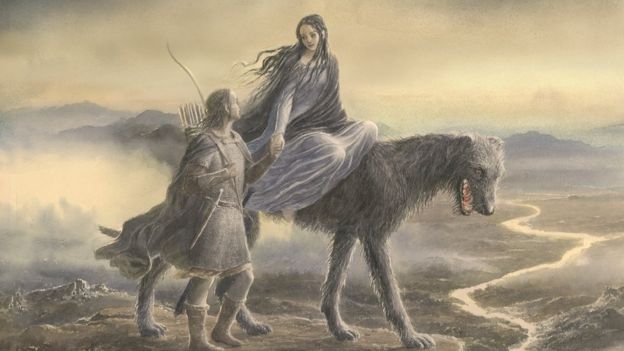Beren and Lúthien has been on a 100-year journey from conception to publication. Like previous posthumous works of Tolkien, such as Children of Hurin, and The Silmarillion, Beren and Lúthien is edited by J. R. R. Tolkien’s son Christopher Tolkien from old notes and manuscripts that belonged to his father. This book has been on my radar for a long, long time, and I am happy that it is now available.
Summary from Houghton Mifflin Harcourt:
‘The tale of Beren and Lúthien was, or became, an essential element in the evolution of The Silmarillion, the myths and legends of the First Age of the World conceived by J.R.R. Tolkien. Returning from France and the battle of the Somme at the end of 1916, he wrote the tale in the following year.
‘Essential to the story, and never changed, is the fate that shadowed the love of Beren and Lúthien: for Beren was a mortal man, but Lúthien was an immortal Elf. Her father, a great Elvish lord, in deep opposition to Beren, imposed on him an impossible task that he must perform before he might wed Lúthien. This is the kernel of the legend; and it leads to the supremely heroic attempt of Beren and Lúthien together to rob the greatest of all evil beings, Melkor, called Morgoth, the Black Enemy, of a Silmaril.
In this book Christopher Tolkien has attempted to extract the story of Beren and Lúthien from the comprehensive work in which it was embedded; but that story was itself changing as it developed new associations within the larger history. To show something of the process whereby this legend of Middle-earth evolved over the years, he has told the story in his father’s own words by giving, first, its original form, and then passages in prose and verse from later texts that illustrate the narrative as it changed. Presented together for the first time, they reveal aspects of the story, both in event and in narrative immediacy, that were afterwards lost.
Published on the tenth anniversary of the last Middle-earth book, the New York Times bestseller The Children of Húrin, this new volume will similarly include drawings and color plates by Alan Lee, who also illustrated The Lord of the Rings and The Hobbit and went on to win Academy Awards for his work on The Lord of the Rings film trilogy.

Like Túrin Turambar – the tragic hero of The Children of Húrin – before them, a version of Beren and Lúthien’s story appears in the first section of The Silmarillion. What sets this book apart from other posthumous works edited by Christopher Tolkien, is that this book contains multiple tellings of the same story that offers a rare look inside the evolution of one of Tolkien’s first stories in his legendarium. As noted in the summary above, Beren and Lúthien was conceived in 1917 shortly after Tolkien returned from WWI, and the central love story was so important to him that he had Lúthien inscribed on his beloved wife’s tombstone, and Beren inscribed on his own.

Beren and Lúthien opens with a truly fascinating preface from Christopher Tolkien in which he goes in-depth into the origins of the story, the evolution of the story, and why, at the ripe age of 93, he chose this to be his final work. From here, Christopher provides some notes on the Elder Days, which is useful as a refresher for readers of The Silmarillion, and new readers alike. I found these introductory pages captivating. It’s not often you get such a comprehensive look into the mind of an author from someone who knew them as well as their own son.
The first chapter tells the first narrative version of the story which is called “The Tale of Tinúviel.” In this early version Beren – who would eventually be re-imagined as human – is a Gnome, but not in the sense that gnomes are thought of now. Tolkien’s use of the term “gnome” actually stems from the Greek and means “thought intelligence,” and is a race of Elves in this story. In later versions he abandons this word as it was too misleading.
Next, each version of the story is given alongside an essay from Christopher Tolkien documenting the changes from one to the next. The reader is also treated to the multitude of writing styles of J. R. R. Tolkien. While the first version is told more-or-less as a narrative tale, later versions are in a complex poem-like prose that uses purposefully arcane language.
Ultimately, Beren and Lúthien is perfect for fans of J. R. R. Tolkien. The book provides an interesting look into one of his most beloved creations, and the backstory provided by Christopher Tolkien is truly captivating. Fair warning, if you are a casual fan of J. R. R. Tolkien’s, or have mainly stayed within the bounds of The Hobbit and The Lord of the Rings, this book might be a bit on the dense side. Conversely, for those of us who’ve dug deep in the Tolkien mythos it’s a much easier read than The Silmarillion. All-in-all, I found Beren and Lúthien to be the perfect farewell tome by Christopher Tolkien, who has provided Tolkien fans with myriads of unfinished stories about Middle-earth.
More Like This:
Wisdom from Tolkien’s Middle-earth
A Brief History of the First Age of Middle-Earth as Found in the Silmarillion and Other Writings
The Hobbit Life: How The Lord of the Rings Helped Me Become a Better Person

